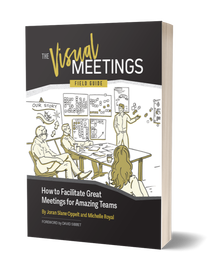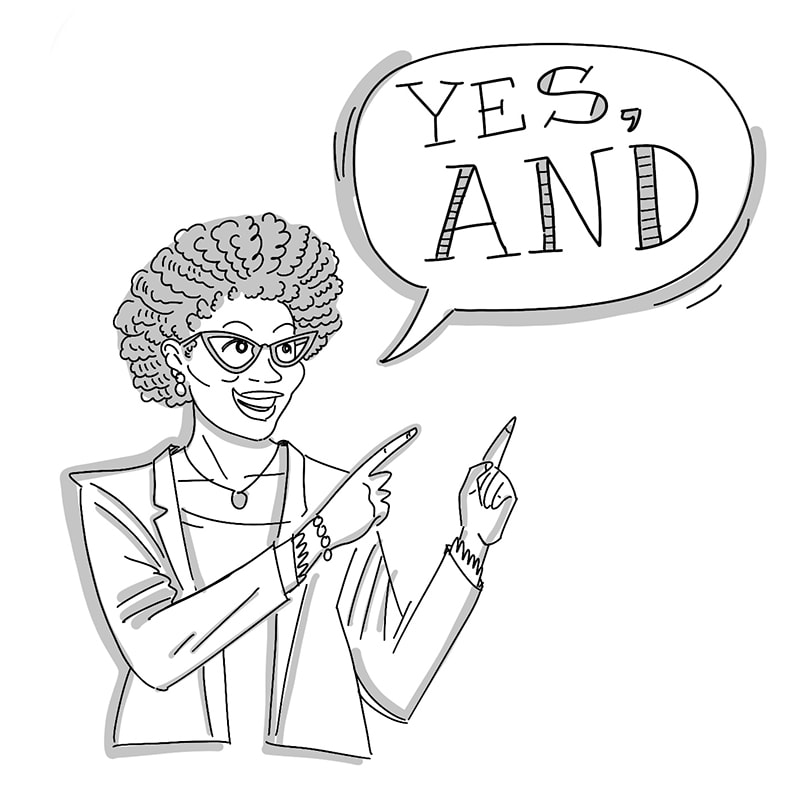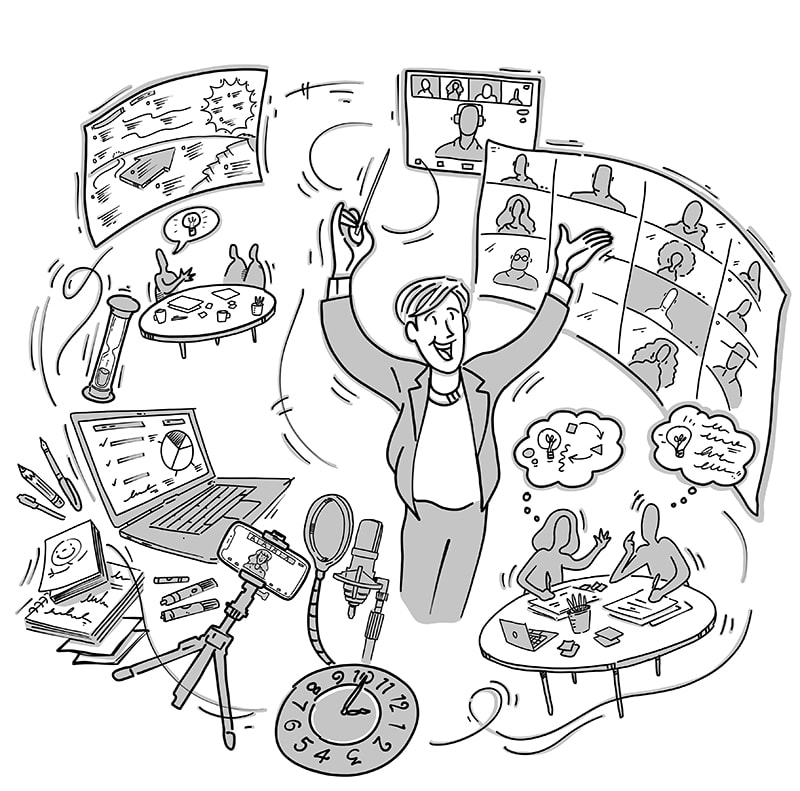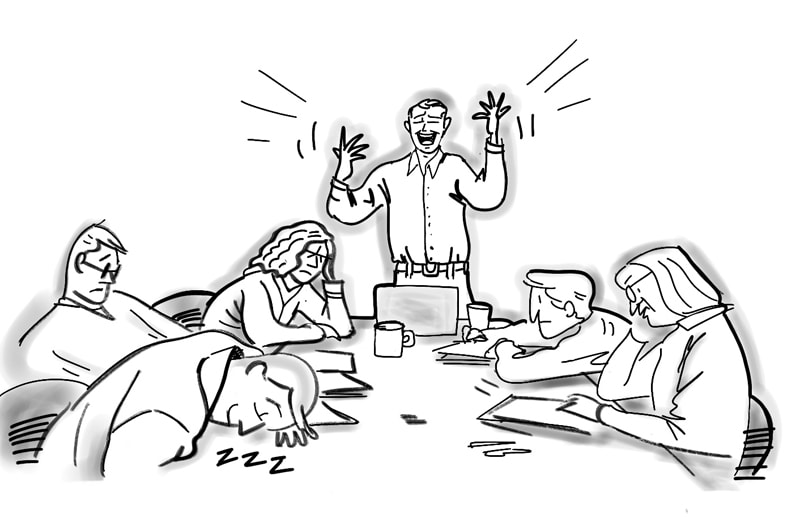|
If you want to inspire the innovation spirit in your meeting, begin with one simple ground rule: “Yes, and...” Here is why it’s important:
BONUS: It even works when used sarcastically. To save time and maximize your collective intelligence, use the phrase “Yes, and...” instead of “no” or “yes, but …” Here’s how to set this up for success: 1. At the beginning of your meeting, establish your objective by answering “At the end of this meeting, what will we have accomplished?” Make the outcome crystal clear. You don’t even have to use the word “innovation.” 2. Next, establish “Yes, and…” as one of the rules. Here’s what you might tell your team: “Many times, when we are in team meetings, we use the words “no” or “yes, but ...” to make our points. Those powerful words can cut off the flow of ideas and solutions. They stop forward movement. “Yes, and” can eliminate negating words and attitudes. Think of volleyball, where the goal is to keep the ball in the air. Just as we would pass the ball to a teammate to get it over the net, we need to trust others with our ideas and know that they have the potential to improve.” 3. Encourage your team to try the sarcastic use. It breaks the ice and allows everyone to understand it really does work. (See “Yes, and…” in Action, below) 4. Proceed through your meeting as normal. And have fun. A small shift in language (and attitude) can provide exponential impact in your team. These simple tools are ways to accelerate your innovation potential into a hard-wired reality. “YES, AND …” IN ACTION Example 1 Facilitator: "Our vision for 2025 is bold." Person 1: "Yes, and it will take all of us performing at our best." Person 2: "Yes, and I know this team is capable." Person 3: "Yes, and I'm glad we are discussing strategy today." Person 4: "Yes, and I'm excited about my new role!" Example 2 Facilitator: “The weather is really bad today.” Person 1: “Yes, and it’ll probably get better.” Person 2: “Yes, and the sun always comes out.” Person 3: “Yes, and when it does, maybe I’ll leave early and go to the beach.” Person 4: “Yes, and maybe I’ll go with you.” Person 5: “Yes, and I’ll bring the sandwiches!” This conversation (or something like it) has been replicated many times by practicing “Yes, and …” as an ice breaker. Notice how it doesn’t take long to turn a complaint about the weather into a beach party. It just takes two simple words.  This is an excerpt from The Visual Meetings Field Guide: How to Facilitate Great Meetings for Amazing Teams - the fully-illustrated master playbook for turning your meetings into engines of productivity and culture. Get your copy on Amazon now.
0 Comments
In my latest book, The Visual Meetings Field Guide: How to Facilitate Great Meetings for Amazing Teams, I laid out the following roles that we have found vital in any virtual meeting or session.
Great virtual facilitation is a team effort. Like the DJ and producer on radio programs, the core duo of facilitator and conductor are at the heart of the virtual experience. Other presenters may add color or interest, and graphic recorders bring their own jaw-dropping magic. 1. Facilitator The facilitator is the pied piper of the session. They design and deliver the attendee experience, guiding the participants through the work effort and into application. The facilitator determines the outcomes and then helps carry them through. They keep the expedition on track (and on time) and leads them through virtual space. 2. Conductor The conductor engineers the session. They act as a director or broadcast engineer, changing sets, switching cameras, and acting as hype-man for the facilitator. The conductor helps to build the virtual architecture the participants will move through. They primarily keep their head down, with one eye on the script or field guide and the other eye on the timer. They may also act as DJ, link paster, breakout facilitator and announcer. Even more than the facilitator, the conductor is meticulously aware of the agenda and the details of delivery. 3. Graphic Recorder The graphic recorder is a scribe, capturing content and reflecting it back in real time. The facilitator needs to mindfully guide participant attention to the graphic recorder. Through constant telepresence, moments of screen share or “gallery walks” the facilitator can share the graphic recorder’s work. The reveal can act as a leg stretch, a Q&A (What do you see? What did we miss?), a wow moment, an energy barometer, or a magic trick. 4. Presenter Presenters are the special attraction. They are invited into a session as a guest. The facilitator transfers esteem to the presenter through their introduction. A presenter’s main job is to deliver content. Presenters are subject matter experts and usually come with their own slides. Just as in face-to-face facilitations, presenters may need additional information about the meeting or the participants in advance (How many people? Who are they? What are their roles in the company? What are their needs/big wishes?). 5. Consultant A consultant is a high-performance thinking partner. In meetings, they post up, brainstorm, listen, reflect, and make recommendations. Consultants are sometimes experts in specialty areas (entrepreneurship, manufacturing, non-profits, marketing, etc.). They aim to deliver supreme value as temporary team members. Consultants may facilitate or co-facilitate, but they never act as the conductor. The first thing to ask yourself (or your team) is: will our meetings help us reach our goals?
Consider this: If you don’t have goals and you are in a meeting to evaluate and make decisions about vendors or a specific technology, the meeting is pointless. You won’t know what technology or partners you’ll need if you don’t know what you want to achieve. A better beginning would be a goal-setting session to determine the purpose and outcomes of any future meetings. Here are some initial questions to determine whether a meeting is even necessary:
Successful meetings always further your team’s goals and always require their collective genius to make progress. If these criteria aren’t met, you have no reason to meet. Here are the Top 10 signs your meetings are unnecessary or need to radically change:
This is just the tip of a very boring and painful iceberg. If you have experienced any of these symptoms, my latest book, The Visual Meetings Field Guide was written to help you design meetings that are fun, energizing and prime your team for action. From now on, your meetings will galvanize culture and get things done. |
Details
ABOUT THE AuthorJoran Slane Oppelt is an international speaker, author and consultant with certifications in coaching, storytelling, design thinking and virtual facilitation. Archives
March 2024
Categories
All
|





 RSS Feed
RSS Feed